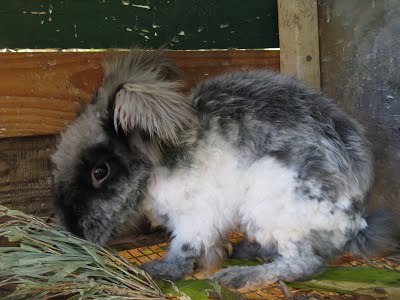Chinchilla is a color determined by the 'C' gene. It's not the dominant "C" for Color (as opposed to the double recessive 'cc' for albino) but several levels down from being dominant. The 'C' gene is a bit complicated, it's the dominant C, then Chinchilla Dark, Chinchilla Light, Himilayan, then Albino, I think, in levels of dominance.
The color genetics on your Chinchilla should be: (cchd=Dark Chinchilla) A_ B_ cchd_ D_ E_. The 'A' is the agouti color pattern. White around the eyes, in the ears and the undercarriage. A double recessive 'aa' is for solid colors. The dominant 'B' is for Black when it is dominant or brown (chocolate) when it's a double recessive (bb). Then there is the complicated 'C' gene and your rabbit has the 'cch' for Dark Chinchilla. There could still be a recessive for light chinchilla, himilayan or albino hiding behind the dark chinchilla gene. The 'D' is for Dense color when it's dominant or with a double recessive (dd) the dilute colors. The 'E' gene when it's a double recessive 'ee' creates torts if it's a bunny with the 'aa' for solid colors and fawns if it has the dominant 'A' for agouti pattern.
With your black, the color genetics for that is a double recessive 'aa' for the solid color pattern and then dominants all the rest of the way. 'aa B_ C_ D_ E_'.
The blank underlines means there could be another dominant gene in that space or it could be a recessive gene in that space, you won't know unless one of the parents had a color that required a double recessive (chocolate, albino, blue, tort, etc.). Then you'd know that their offspring has to have a recessive for that color.
So, 'A_B_cchd_D_E_' from your chinchilla plus 'aa B_C_D_E' from your black could come up with almost anything since there's so many places that recessives could be hiding. Also, we don't know what those specks on the black are all about. Silvering gene? Vienna?
If you want a solid hide color - solid black - and if your Chinchilla doesn't have a solid colored parent or some solid colored ancestor (i.e. he has two dominant 'A' genes - 'AA'), all you are going to get from him is more agouti color patterns and no solid colors. Since Chinchilla is an agouti color pattern color (that dominant 'A'), if your chinchilla has two dominant 'A' genes, then a dominant 'A' is all they can give to their offspring. Which means ALL their offspring will have the agouti pattern and no blacks at all. However, if bred to a black, all the offspring will have 'Aa' and the ability to sire solid colors. If you get any solid colors from this breeding, then you will know that your Chinchilla buck has 'Aa'.




